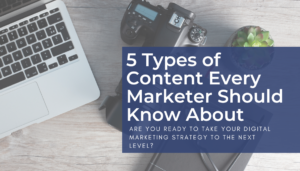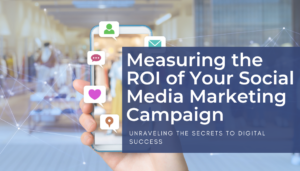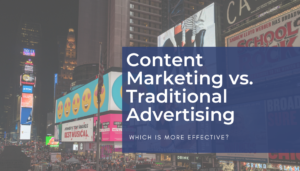Are you ready to take your digital marketing strategy to the next level? In today’s competitive landscape, creating engaging and valuable content is crucial for capturing your audience’s attention. But with so many content types available, it can be overwhelming to know where to start. Fear not! In this blog post, we will unveil five essential content types that every marketer should know about. From blog posts to videos and interactive experiences, we’ll explore the what, how, where, and why of each concept. So buckle up and get ready to revolutionize your content marketing efforts!
Video Content: Captivate with Visual Storytelling
In today’s fast-paced digital world, capturing your audience’s attention requires more than just text-based content. Video content has emerged as a powerful tool for marketers to engage and connect with their target audience. With its ability to convey emotions, tell stories, and demonstrate products or services, videos have become a preferred medium for digital marketing strategies.
What Makes Video Content Effective?
Videos have several unique qualities that make them highly effective in capturing and retaining viewers’ attention:
- Visual Appeal: Videos combine visual elements, including colors, motion, and imagery, to create a captivating experience. The human brain processes visual information faster and more effectively than text, making videos an ideal medium for storytelling and communication.
- Emotional Impact: Videos have the power to evoke emotions, which helps create a stronger bond between the brand and the viewer. By tapping into emotions such as happiness, excitement, or empathy, marketers can forge a deeper connection and drive action from their audience.
- Storytelling Potential: Video content enables brands to tell compelling stories in a way that resonates with their target audience. Through narratives, characters, and plotlines, videos can communicate brand values, showcase customer success stories, or educate viewers about complex topics in an engaging and memorable way.
- Demonstrations and Explanations: For products or services that require visual demonstrations or explanations, videos are a highly effective medium. Whether it’s showcasing the features of a new gadget or guiding customers through a step-by-step tutorial, videos provide a comprehensive and immersive experience that text alone cannot replicate.
- Mobile-Friendly and Shareable: With the increasing use of smartphones, videos have become easily accessible to users on the go. Mobile devices provide an ideal platform for consuming video content, making it crucial for marketers to optimize their videos for mobile viewing. Additionally, videos have high shareability potential, as users are more likely to share interesting or entertaining video content with their social networks, leading to increased brand exposure.
How to Create Engaging Video Content
To create compelling video content that captivates your audience, consider the following tips:
- Plan Your Video Strategy: Identify your goals, target audience, and key messages before diving into video production. Align your video content with your overall marketing strategy to ensure consistency and effectiveness.
- Storytelling and Scriptwriting: Craft a compelling story or script that grabs attention from the start and keeps viewers engaged until the end. Consider the narrative structure, emotional hooks, and a clear call to action.
- High-Quality Production: Invest in good equipment, including cameras, lighting, and audio devices, to ensure a professional-looking video. Poor production quality can negatively impact the audience’s perception of your brand.
- Visual and Audio Elements: Utilize visual effects, animations, music, and sound effects strategically to enhance the storytelling experience and evoke the desired emotions. Consistency in branding elements, such as colors and logos, helps reinforce brand recognition.
- Optimize for SEO: Implement relevant keywords in video titles, descriptions, and tags to improve search engine visibility. This optimization helps your videos appear in search results, increasing the chances of reaching a wider audience.
- Promote and Distribute: Once your video is complete, share it across multiple platforms, including your website, social media channels, email newsletters, and video-sharing platforms like YouTube or Vimeo. Leverage the power of social media advertising to amplify your video’s reach and engagement.
Remember, creating engaging video content is an iterative process. Continuously monitor and analyze viewer engagement metrics, such as views, watch time, likes, comments, and shares, to gain insights and refine your video strategy for optimal results.
FAQ: How can you leverage the power of video content to elevate your brand’s marketing efforts?
By incorporating video content into your marketing strategy, you can leverage the power of visual storytelling to engage and captivate your audience. Videos have the unique ability to convey emotions, demonstrate products, and share compelling stories, making them an invaluable asset in today’s digital landscape. So, are you ready to harness the power of video content and take your marketing to new heights?
Interactive Content: Engage and Educate
In a world filled with an overwhelming amount of content, engaging and educating your audience has become more challenging than ever before. This is where interactive content comes to the rescue! Interactive content takes the concept of audience engagement to a whole new level by encouraging active participation, providing personalized experiences, and fostering a deeper connection between brands and their consumers.
What is Interactive Content?
Interactive content is any form of digital content that requires active engagement from the audience. Unlike traditional static content, interactive content invites users to interact, respond, and make choices, leading to a dynamic and immersive experience. This type of content facilitates two-way communication, allowing brands to gather valuable data and insights while providing value to their audience.
The Power of Interactive Content
Why should marketers embrace interactive content in their digital marketing strategies? Let’s explore the compelling benefits:
- Higher Engagement Levels: Interactive content captivates users and holds their attention for longer periods compared to static content. By offering an interactive experience, you encourage users to invest time and effort, resulting in increased engagement and brand recall.
- Personalized User Experience: Interactive content allows for personalization based on user responses and choices. By tailoring the content to individual preferences and needs, you create a more relevant and meaningful experience for each user.
- Data Collection and Insights: When users engage with interactive content, they provide valuable data that can be used to understand their preferences, pain points, and behavior. This data-driven approach enables marketers to make informed decisions and refine their strategies accordingly.
- Social Sharing and Virality: Interactive content has a higher likelihood of being shared across social media platforms due to its unique and engaging nature. When users find interactive content enjoyable or insightful, they are more likely to share it with their networks, leading to increased brand visibility and organic reach.
- Lead Generation and Nurturing: Interactive content is an excellent tool for generating leads and nurturing them through the marketing funnel. By offering valuable content in exchange for user information, marketers can build a database of engaged prospects.
Top Interactive Content Ideas
If you’re ready to incorporate interactive content into your marketing arsenal, consider these innovative ideas:
- Quizzes and Assessments: Create engaging quizzes related to your industry, products, or services. Assessments that provide personalized recommendations based on user responses are also highly effective.
- Calculators and Tools: Develop interactive calculators that help users solve problems, make decisions, or estimate savings. These tools offer practical value and keep users coming back for more.
- Polls and Surveys: Gather valuable feedback and insights from your audience through interactive polls and surveys. This not only engages users but also shows that you value their opinions.
- Interactive Infographics: Transform complex data and statistics into visually appealing and interactive infographics. This approach enhances comprehension and creates a memorable experience for users.
- Interactive eBooks and Whitepapers: Elevate traditional content formats like eBooks and whitepapers by incorporating interactive elements such as clickable images, quizzes, or interactive graphs.
FAQ: How can I create interactive content without advanced technical skills?
Creating interactive content may sound intimidating, but there are several user-friendly tools and platforms available that require little to no coding or technical expertise. Many content management systems (CMS) offer plugins or integrations that enable you to create interactive elements easily. Additionally, interactive content creation platforms provide templates and drag-and-drop interfaces that simplify the process, making it accessible to marketers of all skill levels.
Blog Posts: Inform, Educate, and Establish Authority
In the ever-evolving landscape of digital marketing, blog posts continue to be a tried-and-true content type that offers significant value to both brands and their audiences. A well-crafted blog post has the power to inform, educate, and establish authority within a specific industry or niche. Let’s delve deeper into why blog posts are essential for your content marketing strategy and explore how you can create compelling blog posts that captivate your readers.
The Impact of Blog Posts
Blogging has evolved from a simple online diary to a powerful tool for brands to share their knowledge, insights, and expertise with their target audience. Here are some reasons why blog posts remain a crucial component of a successful content marketing strategy:
- Information Hub: Blog posts serve as an information hub where audiences can find answers to their questions, solutions to their problems, and valuable industry-related updates. By providing valuable and relevant content, you position your brand as a reliable and trustworthy source of information.
- SEO Benefits: High-quality blog posts that are optimized with relevant keywords can significantly improve your website’s search engine rankings. When you consistently publish valuable content, search engines recognize your site’s authority, leading to increased organic traffic and visibility.
- Thought Leadership: Consistently sharing informative and thought-provoking blog posts helps establish your brand as a thought leader in your industry. As readers see your expertise shine through your content, they’re more likely to view your brand as a go-to resource.
- Audience Engagement: Blogs offer an opportunity for direct communication with your audience through comments and social shares. Engaging with your readers fosters a sense of community and encourages them to return for more insightful content.
How to Create Compelling Blog Posts
Crafting blog posts that resonate with your audience and establish your authority requires thoughtful planning and execution. Here are some steps to help you create compelling blog posts:
- Understand Your Audience: Conduct in-depth research to understand your target audience’s interests, pain points, and preferences. Tailor your blog content to address their specific needs and challenges.
- Choose Relevant Topics: Brainstorm relevant topics that align with your brand’s expertise and your audience’s interests. Use keyword research tools to identify trending topics and optimize your blog posts for SEO.
- Craft Captivating Titles: Your blog post titles should be attention-grabbing and compelling. A well-crafted headline entices readers to click through and read the full article.
- Provide Value: Offer valuable and actionable insights in your blog posts. Whether it’s a step-by-step guide, industry trends, or insider tips, make sure readers walk away with something valuable.
- Engaging Writing Style: Write in a clear, concise, and engaging manner. Avoid jargon and complex language that may alienate readers. Use storytelling techniques to keep readers hooked from start to finish.
- Use Visuals: Incorporate relevant images, infographics, and videos to enhance the visual appeal of your blog posts. Visual elements break up the text and make the content more engaging and shareable.
- Internal and External Linking: Use internal links to direct readers to other relevant blog posts on your website. Additionally, include credible external links to authoritative sources, which can boost your blog’s credibility.
- Call to Action: End each blog post with a strong call to action (CTA) that encourages readers to take the next step, such as subscribing to your newsletter, downloading a resource, or contacting your team.
FAQ: How often should I publish blog posts?
The frequency of publishing blog posts depends on your resources, content creation capabilities, and the expectations of your audience. Consistency is key, so aim to establish a regular publishing schedule that you can maintain. Whether it’s once a week or once a month, the focus should be on delivering high-quality, valuable content to your readers.
Infographics: Simplify Complex Information
In a world where information overload is the norm, simplifying complex data and presenting it in an easily digestible format is the key to capturing and retaining your audience’s attention. This is precisely where infographics shine. Infographics are visual representations of information, data, or knowledge that condense complex concepts into eye-catching graphics. By combining colors, icons, charts, and text, infographics communicate complex information in a visually engaging manner, making them a powerful tool for content marketing and communication.
The Power of Infographics
Infographics have become a staple in content marketing for several compelling reasons:
- Visual Appeal: Humans are highly visual beings, and infographics capitalize on this innate preference. By presenting information in a visually appealing and organized way, infographics quickly capture attention and encourage further exploration.
- Information Retention: Studies have shown that people remember information better when it’s presented visually. Infographics leverage visual memory to create a lasting impact on the audience, making complex data easier to comprehend and recall.
- Simplified Communication: When dealing with complex data or detailed explanations, infographics serve as a means to simplify information without sacrificing its essence. By breaking down complex ideas into bite-sized visual chunks, infographics make comprehension effortless.
- Increased Shareability: Infographics are highly shareable across various digital platforms and social media networks. Their visually stimulating nature encourages users to share them with their audiences, leading to increased brand visibility and exposure.
- Brand Authority: When you present industry-specific data or insights in a professional and well-designed infographic, you position your brand as an authority in your field. This builds trust and credibility with your audience.
How to Create Engaging Infographics
Designing an effective infographic requires a thoughtful approach and attention to detail. Here are some steps to help you create engaging infographics that simplify complex information:
- Define the Purpose: Identify the central message or key takeaways you want your infographic to convey. Understand your target audience and tailor the content to address their specific interests and pain points.
- Data Selection and Organization: Gather relevant data and information from credible sources. Organize the data logically to tell a cohesive and visually appealing story.
- Choose a Design Style: Select a design style that aligns with your brand identity and resonates with your audience. Whether it’s minimalist, colorful, or illustrative, ensure the design complements the content.
- Use Visual Hierarchy: Emphasize the most critical information using visual hierarchy. Use bold colors, larger fonts, or icons to highlight key points and guide the reader’s attention.
- Keep It Simple: Avoid cluttering the infographic with too much information. Focus on conveying the essential details concisely, allowing for a clear and unambiguous message.
- Use Icons and Symbols: Utilize icons and symbols to represent data, concepts, or actions. Icons are universally understood and can replace lengthy text descriptions, making the infographic more user-friendly.
- Provide Context: Include brief explanations or captions alongside data points to provide context and aid comprehension.
- Optimize for Sharing: Ensure the infographic is easily shareable across social media platforms. Include social sharing buttons and embed codes to encourage sharing and increase its reach.
FAQ: Can infographics be used for any industry or topic?
Absolutely! Infographics are versatile and can be used in virtually any industry or on a wide range of topics. From presenting survey results, and explaining complex processes, to showcasing product comparisons, infographics can simplify information across diverse subject areas. Whether you’re in finance, healthcare, technology, or any other field, infographics are a powerful content type to engage your audience.
Podcasts: The Power of Audio Storytelling
In a fast-paced world where time is a precious commodity, audio content has emerged as a compelling and convenient way to connect with audiences on a deeper level. Podcasts, in particular, have experienced an explosive rise in popularity, transforming the way we consume information and entertainment. Podcasts offer a unique form of content that engages listeners through audio storytelling, enabling brands to build a loyal and engaged audience. Let’s dive into why podcasts are an essential content type and explore how you can harness the power of audio storytelling to elevate your brand.
The Appeal of Podcasts
Podcasts have become a preferred medium for both creators and listeners due to several inherent advantages:
- Convenient Consumption: Podcasts allow listeners to multitask and consume content while on the go. Whether commuting, exercising, or doing household chores, audiences can tune in to podcasts without needing their undivided attention.
- Human Connection: Audio storytelling creates an intimate and personal connection with the audience. Hearing real voices and emotions fosters a sense of familiarity and trust, making it easier for listeners to relate to the content and the brand behind it.
- Long-Form Content: Unlike short-form content prevalent on social media, podcasts provide an opportunity for in-depth discussions and conversations. Brands can explore complex topics, share expert insights, and provide value without time constraints.
- Versatile Content: Podcasts cover a wide range of topics and genres, making them appealing to diverse audiences. From educational and informative shows to entertaining narratives and interviews, there’s a podcast for every interest.
- Monetization Potential: For businesses, podcasts offer a platform for monetization through sponsorships, advertisements, and premium subscriptions. As your podcast gains popularity, it can become a revenue stream for your brand.
Harnessing the Power of Audio Storytelling
Creating a successful podcast requires thoughtful planning and execution. Here are key steps to harness the power of audio storytelling for your brand:
- Define Your Podcast’s Purpose: Determine the primary focus and objectives of your podcast. Are you educating your audience, sharing industry insights, or entertaining them? A clear purpose guides content creation and appeals to the right audience.
- Develop Engaging Content: Plan your podcast episodes to deliver value to your listeners. Research and outline each episode, ensuring it follows a logical flow and maintains the audience’s interest.
- Embrace Authenticity: Authenticity is the heart of successful audio storytelling. Be genuine, and let your personality shine through your words. This builds a deeper connection with your audience.
- Invest in Quality Production: High-quality audio production is essential for a polished and professional podcast. Invest in good microphones, recording software, and editing tools to ensure clear and crisp sound.
- Publish Regularly: Consistency is key to building and retaining a loyal audience. Establish a regular publishing schedule, whether it’s weekly, bi-weekly, or monthly, and stick to it.
- Promote Your Podcast: Market your podcast across various channels, including social media, your website, and email newsletters. Collaborate with influencers or guest experts to reach new audiences.
- Engage with Your Audience: Encourage listener feedback and engage with your audience through social media and podcast reviews. This creates a sense of community and encourages listeners to become brand advocates.
FAQ: Do I need professional recording equipment to start a podcast?
While professional recording equipment can enhance the quality of your podcast, it’s not an absolute requirement to get started. Many successful podcasts began with basic equipment and improved over time as they grew their audience and resources. You can start with a decent microphone, free recording software, and a quiet recording space. As your podcast gains traction, consider investing in higher-quality equipment for better production value.
Final Thoughts
In today’s content-saturated world, it’s essential for marketers to diversify their content strategy. By incorporating the five types of content discussed in this blog post – videos, interactive content, blog posts, infographics, and podcasts – you can engage your audience on multiple levels and stand out from the crowd. Experiment with these content types, track your results and adapt your strategy accordingly. Remember, great content is the key to capturing attention, building relationships, and driving business success. So, which content type will you explore first?
Ready to supercharge your content marketing strategy? Darksky Digital is here to help! Our full-service, data-driven digital marketing agency specializes in creating compelling content that drives results. Whether you need captivating videos, engaging infographics, or a well-crafted blog, our team of experts has got you covered. Contact us today to
View more posts on our blog:
- Understanding the Basics of Pay-Per-Click Advertising: A Beginner’s Guide

- 5 Types of Content Every Marketer Should Know About

- The Impact of Customer Reviews on Your Online Reputation

- Measuring the ROI of Your Social Media Marketing Campaign: Unraveling the Secrets to Digital Success

- Content Marketing vs. Traditional Advertising: Which is More Effective?

- Title: The Future of SEO: Unlocking the Secrets to Digital Success


